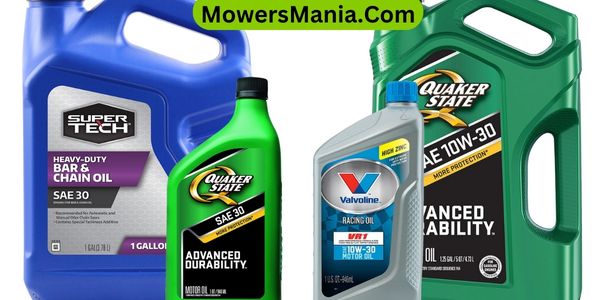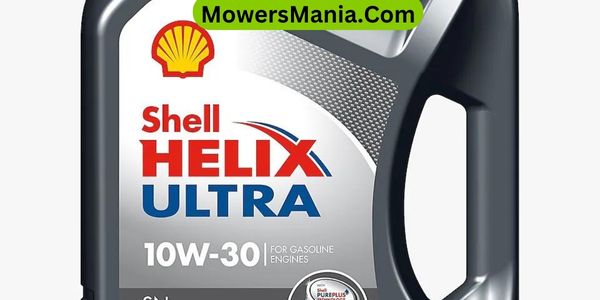Hey there, ever wonder why choosing between SAE 30 and 10W-30 oil for your lawn mower is like picking between a summer outfit and a winter coat? Both oils are suitable for your mower, but they serve different functions.
SAE 30 is like that reliable summer outfit that performs well in warmer temperatures, while 10W-30 is the versatile winter coat that adapts to varying weather conditions.

Understanding the differences can help you ensure your mower runs smoothly and efficiently, no matter the season or mowing conditions. Let’s dive into the specifics and demystify the distinction between these two oils.
Viscosity Grades Explained
If you’re wondering about viscosity grades, they indicate the oil’s flow characteristics at different temperatures.
The ‘W’ in 10W-30 stands for ‘winter,’ and it means the oil has been tested at colder temperatures. The number before the ‘W’ indicates how the oil flows at 0°F. In the case of 10W-30, the oil behaves like a 10-weight oil at 0°F.
As the temperature rises, the second number, 30 in this case, represents how the oil flows at 212°F. The higher the number, the thicker the oil.
On the other hand, SAE 30 oil doesn’t have the ‘W’ designation, which means it hasn’t been tested at lower temperatures. As a result, it may not flow as well as 10W-30 in colder conditions.
SAE 30 is a single-grade oil, meaning it has a consistent viscosity throughout the temperature range. In summary, the viscosity grades help you understand how the oil will perform in varying temperatures, making it crucial to choose the right one for your lawnmower.
Temperature Performance Differences
When choosing between SAE 30 and 10W-30 oil for your lawn mower, consider how their temperature performance differs.
SAE 30 oil is a single-grade oil, meaning it has a consistent viscosity rating regardless of temperature. It’s well-suited for use in warmer climates where the temperature remains relatively stable.
On the other hand, 10W-30 oil is a multi-grade oil that provides different viscosities depending on the temperature. The ’10W’ indicates the oil’s viscosity in cold weather, while the ’30’ represents its viscosity at operating temperature.
This means that 10W-30 oil offers better cold-start protection, making it suitable for use in regions with fluctuating temperatures or in colder seasons.
In hotter temperatures, SAE 30 oil can become too thin, leading to decreased lubrication and potential engine wear. Conversely, 10W-30 oil maintains its viscosity across a wider temperature range, providing better overall protection for your lawn mower engine.
When considering temperature performance differences, it’s important to choose the oil that aligns with the climate and seasonal conditions in which you’ll be operating your lawn mower.
Engine Compatibility Factors

Consider your lawn mower’s engine compatibility with different oil viscosities.
The type of oil you use can affect how well your engine performs and how long it lasts.
Some older lawn mower engines are designed to work best with SAE 30 oil, while newer models may benefit from the improved cold-weather starting provided by 10W-30 oil.
It’s essential to consult your mower’s manual to determine which oil viscosity is recommended for your specific engine.
Using the wrong viscosity could lead to increased wear and tear, decreased efficiency, and even engine damage.
Additionally, some lawn mowers, especially those with variable speed or hydrostatic transmissions, may require oil with specific additives to ensure optimal performance.
Always check the specifications provided by the mower’s manufacturer to ensure that the oil you choose meets the necessary standards for your engine.
Cold Start Considerations
To ensure smooth cold starts for your lawn mower, consider the impact of different oil viscosities. When choosing between SAE 30 and 10W-30 oils, cold start considerations are crucial for the optimal functioning of your mower’s engine.
Here’s what you need to keep in mind:
- Viscosity at Low Temperatures: 10W-30 oil has better cold-temperature flow compared to SAE 30. This means it provides easier starts and better initial engine lubrication during cold weather, reducing wear and tear on the engine components.
- Cold Weather Performance: In colder climates, 10W-30 oil is preferable as it remains fluid at lower temperatures, ensuring that your mower’s engine is adequately lubricated during cold starts, which can be challenging for thicker oils like SAE 30.
- Quick Lubrication: The lower viscosity of 10W-30 oil allows it to reach critical engine parts more quickly during cold starts, reducing the risk of dry starts and minimizing engine wear.
Understanding these cold start considerations will help you make an informed decision when choosing the right oil for your lawn mower, ensuring optimal performance and longevity, particularly in colder weather.
Maintenance and Usage Guidelines

Are there specific maintenance and usage guidelines for each type of oil in order to maximize the performance of your lawn mower?
Absolutely! Proper maintenance and usage of the correct oil are crucial for the longevity and efficiency of your lawn mower.
Here are some guidelines to help you make the most of SAE 30 and 10W-30 oils:
| Maintenance and Usage Guidelines | SAE 30 Oil | 10W-30 Oil |
|---|---|---|
| Change Interval | Every 50 hours of use or at the beginning of each mowing season | Every 25 hours of use or at the beginning of each mowing season |
| Temperature Range | Best for warmer temperatures | Suitable for a wide range of temperatures, including cold starts |
| Viscosity | Higher viscosity, not suitable for cold starts | Lower viscosity, suitable for cold starts |
| Compatibility | Ideal for older lawn mower models | Suitable for newer and older models |
Following these guidelines will ensure that your lawn mower operates at its best, providing you with a well-maintained and reliable tool for keeping your lawn in top condition. Always refer to your lawn mower’s manual for specific maintenance and oil recommendations.
Frequently Asked Questions [FAQs]
Can I Use SAE 30 and 10W-30 Interchangeably in My Lawn Mower?
Yes, you can use SAE 30 and 10W-30 interchangeably in your lawn mower. Both are suitable for small engines. However, consider the temperature range and manufacturer’s recommendations for optimal performance.
Are There Any Specific Additives I Should Look for in SAE 30 or 10W-30 Oil for My Lawn Mower?
When choosing SAE 30 or 10W-30 oil for your lawn mower, look for additives like detergents and dispersants to keep the engine clean and protect against deposits. These additives can enhance performance and prolong engine life.
How Often Should I Change the Oil in My Lawn Mower When Using SAE 30 or 10w-30?
When using SAE 30 or 10W-30 oil in your lawn mower, change the oil after every 25 hours of use or at the beginning of each mowing season. Regular oil changes help maintain engine performance and longevity.
Are There Any Potential Long-Term Effects on My Lawn Mower’s Engine From Using SAE 30 or 10W-30 Oil?
Using SAE 30 or 10W-30 oil in your lawn mower can affect long-term engine performance. SAE 30 is better for warmer temperatures, while 10W-30 provides better cold-weather starting. Always follow the manufacturer’s recommendations for best results.
Can I Mix SAE 30 and 10W-30 Oils Together in My Lawn Mower?
Yes, you can mix SAE 30 and 10W-30 oils in your lawn mower. It’s safe to do so and won’t cause any harm to the engine. Just ensure that you use the correct oil type for your mower.
Conclusion
So, when it comes to choosing between SAE 30 and 10W-30 oil for your lawn mower, consider the temperature conditions, engine compatibility, and cold start factors.
Both oils have their own benefits and considerations, so make sure to follow the manufacturer’s recommendations and maintenance guidelines for optimal performance and longevity of your lawn mower.



